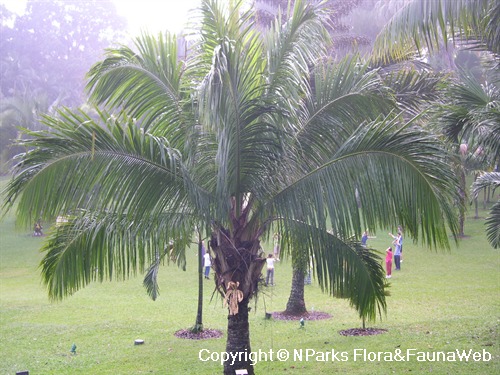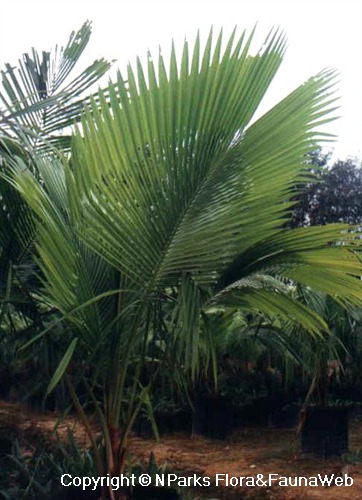
Back
Beccariophoenix madagascariensis
| Family Name: | Arecaceae (Palmae) |
| Common Name: | Manorano Palm, Maruala, Monarana |
Name
Classifications and Characteristics
| Plant Division | Angiosperms (Flowering Seed Plants) |
|---|---|
| Plant Growth Form | Palm (Solitary Habit) |
Biogeography
| Native Distribution | Madagascar |
|---|---|
| Native Habitat | Terrestrial |
| Preferred Climate Zone | Tropical |
Description and Ethnobotany
| Growth Form | Beccariophoenix madagascariensis is a solitary palm, which can reach 12 m tall 30 cm wide in the wild. The stem is tightly woven with brown fibers and the oldest part is ringed with leaf scars. |
|---|---|
| Foliage | The leaves are green, large (about 4.5 m long) and pinnate. They grow almost directly from the top of the trunk with almost no petiole. The leaflets are regularly arranged along the rachis, and can reach up to 90 cm long in mature palms. In young plants, most of the leaflets remain unsegmented. The leaflets of young palm are stiff and become pendent as it matures. |
| Flowers | Inflorescence occurs among the leaves. Flowering stalk is 120 cm long with a fibrous peduncular bract. At maturity, the bract splits open and falls to reveal the flowers, leaving behind a collar-like scar. Beccariophoenix madagascariensis is monoecious, where male and female flowers are mostly borne in triads except the base or tip. Flowers are creamish yellow. |
| Fruit | The fruit are purplish brown, ovoid (about 2.5cm long) with a pointed beak and 1-seeded. |
| Habitat | It is found on low mountainous rain forest where it grow in sandy soil. |
| Etymology | Genus Beccariophoenix commemorates Odoardo Beccari (1843 – 1920), an Indian palm botanist, by combining his name with phoenix – a general name for a palm. Species epithet is latin for ‘of Madagascar’ |
| Ethnobotanical Uses | Food (Fruit or Vegetable) Others: Beccariophoenix madagascariensis was thought to be extinct, until it was rediscovered at Mantadia, near Perinet by botanist John Dransfield in 1986. Leaves are used to make hats and the heart of the palm is harvested for food. |
Landscaping Features
| Landscape Uses | Parks & Gardens |
|---|
Plant Care and Propagation
| Light Preference | Semi-Shade |
|---|---|
| Water Preference | Moderate Water |
| Plant Growth Rate | Moderate |
| Rootzone Tolerance | Well-Drained Soils |
Foliar
| Mature Foliage Colour(s) | Green |
|---|---|
| Leaf Area Index (LAI) for Green Plot Ratio | 2.5 (Palm - Solitary) |
Non - Foliar and Storage
| Trunk Type (Palm) | Solitary Habit, Aboveground |
|---|
Image Repository
Others
| Master ID | 1304 |
|---|---|
| Species ID | 2597 |
| Flora Disclaimer | The information in this website has been compiled from reliable sources, such as reference works on medicinal plants. It is not a substitute for medical advice or treatment and NParks does not purport to provide any medical advice. Readers should always consult his/her physician before using or consuming a plant for medicinal purposes. |

